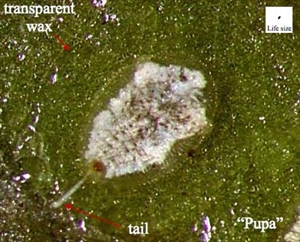Croton whitefly
Pacific Pests, Pathogens, Weeds & Pesticides - Online edition
Pacific Pests, Pathogens, Weeds & Pesticides
Croton whitefly (335)
Orchamoplatus mammaeferus; previously, Aleuroplatus samoanus and Orchamus samoanus.
Southeast Asia, North America (Hawaii), Oceania. It is recorded from Australia, American Samoa, Cook Islands, Fiji1, French Polynesia, New Caledonia, and New Zealand.
Croton; other hosts are: citrus species, frangipani, jasmine, Spondias dulcis ("wi" in Fiji), sweet potato, gourds, Malay apple, allspice, and others.
Both nymphs and adults suck the sap of plants causing the leaves to become crinkled and distorted. In Fiji, it is occasionally found on the underside of croton leaves in large numbers1.
Eggs are white to brown, on stalks; they are laid in rings. The nymphs are oval, flat, and occur on the underside of the leaves with the pupae. The first nymphs are known as 'crawlers'; they have legs are active; after a short time they settle, remaining in one place, feeding and going through several moults. The pupae are also oval, about 0.75 mm long, brownish-yellow, with a coat of transparent wax forming a thin layer around the margin, and a white “tail” (Photo 1). Adults are yellow with red eyes and white, powdery wings (Photo 2).
Spread occurs when crawlers disperse over short distances, or longer when carried by wind currents, vehicles, animals, birds, or on clothing. All stages are spread in the horticultural trade of plants or plant parts.
There is little published information on the impact of this whitefly, except that it causes yellowing and distortion of croton leaves. Crotons are used as informal hedges, pot plants, and for cut foliage, and large infestations of whiteflies would affect their market value.
Look for the nymphs, pupae and adults on the undersides of leaves. Look for the characteristic shape of the pupae, the transparent wax surround, and the "tail".
NATURAL ENEMIES
Ladybird beetles Delphastus pusillus, Halmus chalybeus, Nephaspis oculatus and Serangium maculigerum feed on the croton whitefly.
CULTURAL CONTROL
If using a pesticide to control the croton whitefly, it is best to remove the worse infested foliage before spraying.
CHEMICAL CONTROL
Attempts to control the whitefly using synthetic pesticides are not recommended. Spraying with pesticides may make the problem worse by destroying the biocontrol agents and prolonging the infestation. If pesticides are required, do the following:
- Use horticultural oil (made from petroleum), white oil (made from vegetable oils), or soap solution (see Fact Sheet no. 56). The spray will not kill all of the spiralling whiteflies, but it will suppress the population enough to allow predator and parasite numbers to build up and start to control them.
- Several soap or oil sprays will be needed to bring the whiteflies under control. It is essential that the underside of leaves and terminal buds are sprayed thoroughly since these are the areas where the whiteflies congregate. It is best to spray between 4 and 6 pm to minimise the chance of leaves becoming sunburnt.
- White oil:
- 3 tablespoons (1/3 cup) cooking oil in 4 litres water
- ½ teaspoon pure hand soap, not detergent
- Shake well and use.
- Soap:
-
Use soap (pure soap, not detergent):
- 5 tablespoons of soap in 4 litres water.
-
- White oil:
- Commercial horticultural oil can also be used. Note, these sprays work by blocking the breathing holes of insects causing suffocation and death. They are less likely to kill natural enemies as they are quickly broken down in the environment, and also the development of resistance to them is less likely than is the case when using synthetic pesticides.
____________________
When using a pesticide, always wear protective clothing and follow the instructions on the product label, such as dosage, timing of application, and pre-harvest interval. Recommendations will vary with the crop and system of cultivation. Expert advice on the most appropriate pesticides to use should always be sought from local agricultural authorities.
AUTHOR Grahame Jackson
1Information from Swaine G (1971) Agricultural Zoology in Fiji. Her Majesty's Stationery Office. London; and CABI (2015) Orchamoplatus mammaeferus (croton whitefly). Crop Protection Compendium. (https://www.cabi.org/cpc/datasheet/37757); and Aleyrodidae: Key to the genera. USDA, APHIS, PPQ. (http://keys.lucidcentral.org/keys/v3/whitefly/key/Aleyrodid%20Pupal%20Key%20to%20the%20Genera/Media/Html/Orchamoplatus.htm). Photo 1 Croton whitefly (Orchamoplatus mammaeferus) California Department of Food and Agriculture. Photo 2 MAF Plant Health & Environment Laboratory (2011) Croton Whitefly (Orchamoplatus mammaeferus): PaDIL - (http://www.padil.gov.au).
Produced with support from the Australian Centre for International Agricultural Research under project PC/2010/090: Strengthening integrated crop management research in the Pacific Islands in support of sustainable intensification of high-value crop production, implemented by the University of Queensland and the Secretariat of the Pacific Community.





